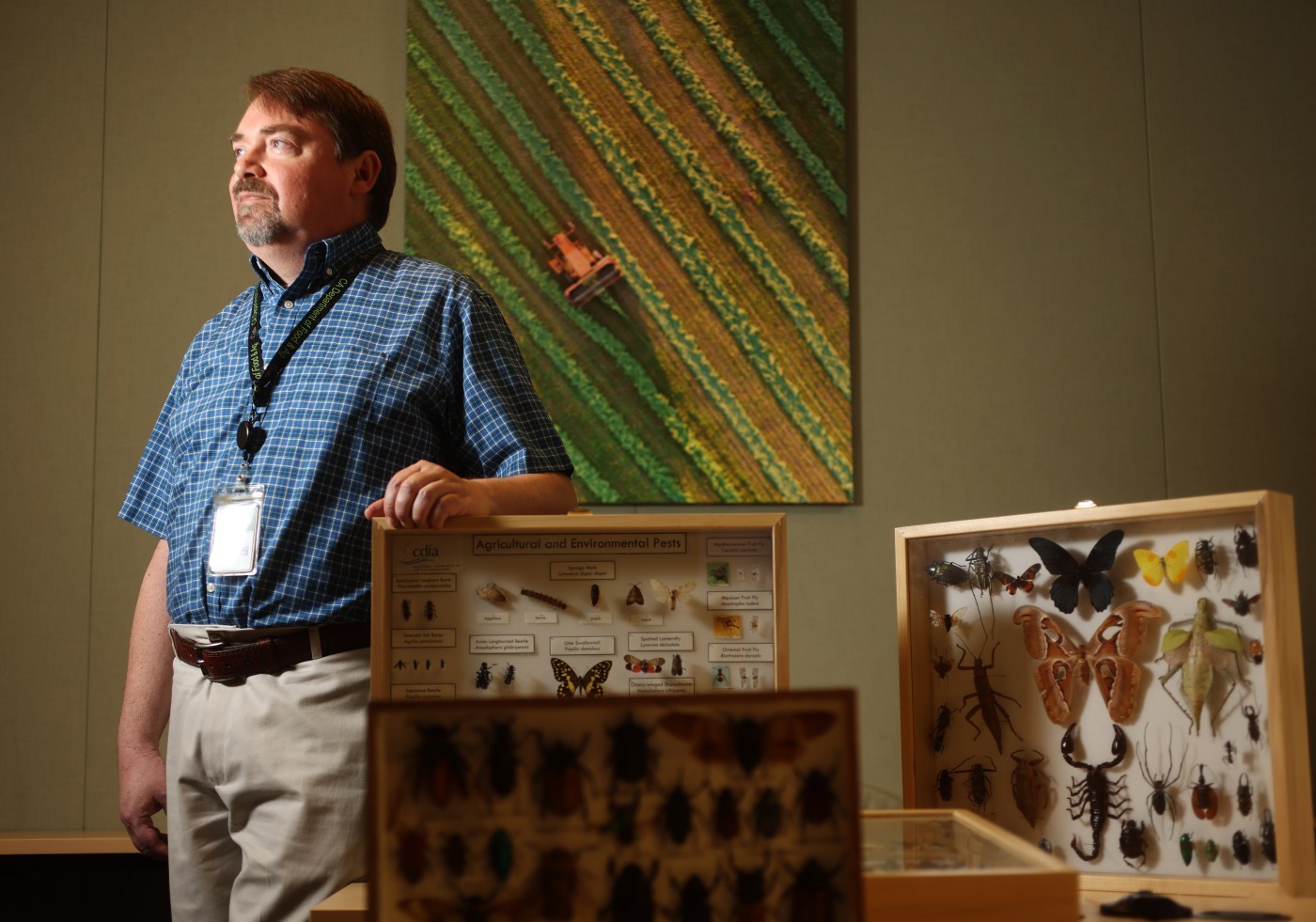This summer, a small number of invasive Mediterranean fruit flies were detected in San Jose. In response, the state started doing something that might seem strange: releasing millions more fruit flies out of airplanes every week to drift down upon the South Bay. (Close your mouth when looking up — kidding!)
But these flies are different. They’re males that have been exposed to radiation to make them sterile. They breed with female flies, but no viable eggs result – thus, the invasion is gradually eradicated. It’s a biological-control strategy that’s been used with success over the years in Southern California, as well as states like Oregon, Florida and Louisiana.
Jason Leathers is the branch chief for Pest Detection/Emergency Projects at the California Department of Food and Agriculture (CDFA). His job is to help fight these teeny-tiny menaces. Though small, the danger they pose is real. Medflies can ruin more than 250 kinds of produce by infecting them with maggots. The department estimates that if the population were uncontrolled, it would cost the state’s agricultural industry as much as $1.8 billion a year.
Medflies are smaller than houseflies, but considerably more destructive. They attack more than 250 species of fruit, flowers and vegetables. (U.S. Department of Agriculture)
Leathers recently took the time to chat about his unusual work and the science behind it, as well as the next looming problems in pest control.
Q: First of all, what does one of these little jerks look like?
A: So it’s about the size of a house fly — a little bit smaller — and it’s really brightly colored. It’s got a black body with silver stripes on the back. It has a clear wing with yellow and black banding on it. It’s quite a beautiful fly, actually.
Q: Where does the species come from?
A: It’s native to the Mediterranean region. It was first found in California in 1975, in Los Angeles, and it’s been found I think in 38 of the 50 years since then. It’s been successfully eradicated every time.
They’re internal fruit feeders, so the females lay eggs under the skin of fruit when it’s still on the tree. People don’t realize it, because the fruit looks just fine. The Medfly is established in Hawaii, Central America and much of the world. So when people travel and bring fruit with them, they can have the Medfly eggs or larvae in it.
Q: Where’d the idea come from to breed and sterilize them?
A: I’m not exactly sure — it probably originated with the International Atomic Energy Agency. After World War II, they were looking for peaceful ways to use this new nuclear energy. One of the peaceful solutions they came up with was SIT (sterile-insect technique). The way we sterilize the flies is they’re briefly exposed to radiation, just enough so they won’t be able to reproduce, but it doesn’t affect their health.
Dr. Jason Leathers, branch chief of Pest Detection/Emergency Projects at the California Department of Food and Agriculture on Monday, Sept. 29, 2025, in Sacramento, Calif. Leathers oversees the department’s program whereupon they drop millions of irradiated fruit flies out of airplanes over the Bay Area. These flies, which carry markers that make them glow under UV light, are reared to never be able to make viable eggs. (Aric Crabb/Bay Area News Group)
Q: Where are the sterilized flies bred?
A: We source them from two different places. The CDFA has a facility in Waimanalo, Hawaii, and then we get that supplemented with additional pupae from Guatemala, where the USDA has a facility.
Q: What does a fly farm look like?
A: It’s a big warehouse, and they’ve got it down to a science where they rear the flies on a special diet. In Hawaii, it starts out with the egg-production chamber where they have a bunch of bottles that are in different temperatures of water with air bubbling through it. Once those eggs are ready, they move them into trays where the eggs hatch and the larvae come out and consume their diet. When the larvae are mature, they crawl out of the edge of the tray and are collected into jars or bottles, then put into different trays where they pupate.
Q: How are they irradiated?
A: They’re put into these chambers, sort of like an old revolver pistol, and get rotated through where they’re briefly exposed to cesium-137. And that sterilizes them.
Related Articles
Gov. Newsom subbing in for Trump at COP30 climate change conference
Fishermen missing in Vietnam as Philippines mourns dead from Typhoon Kalmaegi
At UN climate summit, world leaders say time is running short to stop the worst effects of warming
‘Emerging threat’: An invasive species is upending life in the Delta, with no help on the way
‘Good Fire’ exhibit in Oakland shows native land stewardship practices
Q: And at some point, they’re treated with chemicals that make them glow under UV light?
A: Once they’re pupae, we dust them with a fluorescent dye. That’s how we mark them to differentiate between the sterile and the wild flies. You know when you’re watching firefighting, and the plane releases a fire-retarding chemical with that pink-or-orange color? It pretty much looks like that.
Q: How often are these planes dropping flies in California?
A: Throughout the Los Angeles Basin, we have flights occurring twice per week to release flies. We do that on an ongoing basis to prevent Medflies because, historically, that’s where a lot were coming in. Then whenever we find a population of wild Mediterranean fruit flies elsewhere in California, we’ll have special flights up there. Right now, we have three flights a week to San Jose. … It looks like (that) is probably going to run until March 2026, and could be extended if we continue to find flies.
Q: What does the payload of flies look like?
A: It’s in a big steel box, maybe about 2 feet, kind of a cube. They chill them down to 38 degrees and they become dormant. Then the aircraft has an auger that controls the rate they fall out of those boxes.
Q: What would happen if we weren’t controlling these flies?
A: Basically, fruits and vegetables will become much more expensive. The big growers have a lot of resources and could adapt, but they’d have to use more pesticides. … I believe in 1998, California produced 11% of the world’s table olives. But the olive fruit fly came in and there was no effective trap for it. It spread throughout the state, and now almost all of the olives grown here have to be for olive oil. It really changes the industry, once a fruit fly becomes established.
Also, a third to half of the residential properties in California have fruit trees or vegetable gardens. If Medflies were to establish here, it would infest all of that. A lot of people would probably just give up, when all of their fruit had worms in it all the time.
The spotted lanternfly is now in more than 20 states. (Stephen Ausmus/USDA/ARS)
Q: What can ordinary folks do to help fight Medflies?
A: We really want people to know not to “pack a pest.” When you travel, you might come across fruit that’s extra delicious where you’re visiting, and it seems like it might be a good gift to bring back to friends or family. But that’s a really bad idea because you can bring back larvae with it.
We’ve also had a problem the last couple of years with people selling fruits and vegetables on social media. Some of that is possibly smuggled in illegally. So we need cooperation from the public in buying their fruits and vegetables from good sources.
Q: What other battles are looming with invasive insects?
A: The big one we’re worried about in California is the spotted lanternfly. A lot of people have probably heard about them. We have not found any live ones yet, but it’s a possibility it could show up here. They hitchhike around the country on egg masses that look like splashes of mud. And that’s a big threat, particularly because we grow so many grapes here.
(Note: Residents who think their produce has been infested by fruit-fly larvae can contact California’s pest hotline at 800-491-1899 or by email at [email protected].)
_________________
Jason Leathers
Age: 50
Position: Branch chief for Pest Detection/Emergency Projects, California Department of Food and Agriculture
Education: Ph.D. in entomology from Oregon State University; master’s in entomology from the University of Kentucky; bachelor’s in ecology from the University of Georgia
Residence: Sacramento
_________________
Five things about Jason
1 He grew up in Lawrenceville, Georgia.
2 He enjoys live music and cycling along the American River Bike Trail.
3 His favorite sci-fi movie is “Aliens.”
4 His graduate work focused on parasitic wasps: “They’re kind of what the movie ‘Aliens’ is about.”
5 As an entomologist, he believes it’s morally OK to swat flies: “Yeah, for sure.”





